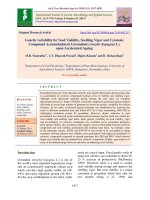Stability estimates for pod yield and its component traits in groundnut (Arachis hypogaea L.) under farmer’s participatory varietal selection
Bạn đang xem bản rút gọn của tài liệu. Xem và tải ngay bản đầy đủ của tài liệu tại đây (324.22 KB, 9 trang )
Int.J.Curr.Microbiol.App.Sci (2018) 7(1): 3171-3179
International Journal of Current Microbiology and Applied Sciences
ISSN: 2319-7706 Volume 7 Number 01 (2018)
Journal homepage:
Original Research Article
/>
Stability Estimates for Pod Yield and Its Component Traits in Groundnut
(Arachis hypogaea L.) under Farmer’s Participatory Varietal Selection
Hasan Khan*, Vinay S. Patted, Muralidhara, B. Arunkumar and I. Shankergoud
AICRP on Groundnut, MARS, UAS, Raichur, Karnataka, India
*Corresponding author
ABSTRACT
Keywords
Groundnut,
Genotype x
environment,
Stability
Article Info
Accepted:
26 December 2017
Available Online:
10 January 2018
Ten promising groundnut varieties were evaluated under farmer’s participatory varietal
selection method to know the genotype × environment interaction at five different
locations. Analysis of variance revealed that the mean squares due to genotype were highly
significant for all the characters studied. Variance due to environments was significant for
all the characters studied except shelling percentage, sound mature kernels and hundred
kernel weight. Significance of variance due to genotypes × environment interaction was
recorded for days to maturity, plant height, shelling percentage, sound mature kernels and
hundred kernel weight. A perusal of data for dry pod yield revealed that six out of the 10
genotypes, (Kadiri-9, Dharani, TG-51, TMV-2, G2-52 and GPBD-5) exhibited nonsignificant deviation from regression. Genotype Kadiri-9 recorded higher mean (1514
kg/ha) than population mean (1405 kg/ha) with regression coefficient of 0.85 for dry pod
yield, indicating this genotype performs well under different environments. Genotype
Kadiri-9 found stable for major traits like dry pod yield, haulm yield and sound mature
kernels indicating the potentiality of this line to exploit the hybrid vigour for pod and
haulm yield.
Introduction
Groundnut (Arachis hypogaea), a segmental
allopolyploid,
self-pollinated
legume.
Popularly known as peanut or poor man’s
cashew. It is widely cultivated legume/oil crop
in more than 114 countries including tropical
to temperate region. It is an important oil, food
and feed legume, where kernels are rich in oil
(48-50 %) and protein (25-28%). It stated that
global groundnut production increased
marginally in last decade by just 0.4% only
(Jenila, et al., 2013, Nigam et al., 2014). Since
Asian and African countries accounts for the
93 per cent of global groundnut production,
where cultivation is predominantly under
rainfed and resource poor conditions. The
lower productivity in groundnut is mainly due
to various biotic and abiotic stresses. Apart
from these, cultivation of age old varieties
which are vulnerable to majority of pests and
diseases and non-availability of improved
quality seeds also plays role. Many a times,
improved varieties will not reach to farmers
due to inefficient extension system and they
may not meet the expectations of farmers,
trader’s, agro-based industries and other
stakeholders.
3171
Int.J.Curr.Microbiol.App.Sci (2018) 7(1): 3171-3179
Yield is a complex character resulting from
interplay of various yield contributing
characters, which have positive or negative
association with yield and among themselves
also. The consistent performance of a
genotype over a range of environments is
essential for a wide stability of a variety.
Stability of genotypes depends upon
maintaining
expression
of
certain
morphological and physiological attributes
and allowing others to vary, resulting in G×E
interactions. G×E interaction has a masking
effect on the performance of a genotype and
hence the relative ranking of the genotype do
not remain the same over number of
environments. Stability of genotypes to
environmental fluctuations is important for
stabilization of crop production both
temporally and spatially. Estimation of
phenotypic
stability,
which
involves
regression analysis, has proven to be a
valuable tool in the assessment of varietal
adaptability. Stability analysis is useful in the
identification of stable genotypes and in
predicting the responses of various genotypes
over changing environments. It is generally
agreed that the more stable genotypes adjust
their phenotypic responses to provide some
measure of uniformity in spite of
environmental fluctuations (Patil et al., 2014).
Therefore, an attempt has been made in
present study to evaluate different groundnut
genotypes across the different locations to
know the role of G×E interactions and also to
analyze the stability ofgenotypes for different
traits.
Materials and Methods
The experiment was conducted during kharif2015 in selected districts of HyderabadKarnataka region. Prior to this, needs of the
farmers were assessed to set goals and identify
farmers’ preference and perception on
ideotype of groundnut cultivars. Based on
assessments ten high yielding groundnut
genotypes (Table 1) were selected from
various research institutes across India along
with farmer’s preferred variety (TMV-2) as
check. The experiment was implemented
through Mother-baby approach (Snapp, 1999)
in the villages of selected districts in
Hyderabad-Karnataka region where groundnut
cultivation is predominant (Table 2).
Each variety was sown in an area of 1000 m2
with spacing of 30×10 cm by following
necessary agronomic practices. Each variety
was grown by three different farmers in same
village and observations viz., days to 50 %
flowering, days to maturity, plant height (cm),
number of pods/plant, shelling percent, sound
mature kernals, hundred kernel weight, dry
pod yield (kg/ha), kernal yield (kg/ha), haulm
yield (kg/ha)was recorded in each plot and in
each environment. The data were analysed for
variance and pooled analysis as suggested by
Panse and Sukhatme (1967). The stability
analysis was carried out according to the
method suggested by Eberhart and Russel
(1966).
Results and Discussion
The mean squares due to genotype were
highly significant for all the characters
studied, which revealed the presence of
substantial amount of variation among the
groundnut genotypes evaluated (Table 3).
Variance due to environments was significant
for all the characters studied except shelling
percentage; sound mature kernels and hundred
kernel weight indicating that environments
selected for study were highly diverse.
Further, it was observed that significance as
variance due to genotypes × environment
interaction for days to maturity, plant height,
shelling percentage, sound mature kernels and
hundred kernel weight indicating that macro
environmental differences were present under
all three environments studied. The significant
mean squares for environment (linear) for
3172
Int.J.Curr.Microbiol.App.Sci (2018) 7(1): 3171-3179
various traits were also reported by Habib et
al., (1986) and Patil et al., (2014). Variance
due to genotypes × environment (linear) was
significant for days to maturity, plant height,
shelling percentage and sound mature kernels.
Significance of variance due to environment
(linear) was observed for all the characters
studied except sound mature kernels (Table 3).
The higher magnitude of mean squares for
environment (linear) compared to genotypes ×
environments (linear) indicated that linear
response of environment accounted for the
major part of total variation for all the
characters studied and may be responsible for
high adaptation in relation to yield and other
traits. Therefore, prediction of performance of
genotypes over environments would be
possible for the various characters. Similar
findings were reported by Thaw are, (2009),
Pradhan et al., (2010), Habib et al., (1986) and
Patil et al., (2014).Variance due to pooled
deviation was significant for all the characters
studied except days to 50 % flowering, days to
maturity, plant height and shelling percentage
indicates genotypes differed considerably with
respect to their stability. The significant
pooled deviation (Non-linear) for various
traits were also reported by Senapati et al.,
(2004), ChuniLal et al., (2006) and Patil et al.,
(2014).
Interactions of genotypes with environments
obtained as the environment + genotype ×
environments (e+g×e) were significant for all
characters except pod yield and kernel yield
(Table 3), which suggested the distinct nature
of environments and genotype × environment
interactions in phenotypic expression. The
significant environment + (genotype ×
environment) interactions for various traits
were also reported by Joshi et al., (2003) and
Patil et al., (2014).
In the present investigation, model proposed
by Eberhart and Rusell (1966) was used for
analysis of G×E interactions. This model
considered both linear (bi) and non-linear
(S2di) components of G×E interactions for the
prediction of performance of the individual
genotype. Higher mean performance of
genotype for various characters along with
regression coefficient (bi) as measures of
responsive and deviation from regression
(S2di) as a measure of stability were used to
assess the stability and suitability of
performance over environments. The high
mean performance of genotypes was taken on
the basis of average performance of all
genotype as population mean.
The overall mean performance of the
genotypes for days to 50 per cent flowering
revealed that genotypes viz.,Dharani (29),
Kadiri Haritandra (28), TG-51 (28), TMV-2
(28) and GPBD-5 (28) recorded lower mean
value than the population mean (29.11) with
non-significant deviation from the regression
(Table 4). Two genotypes, TPG-41 (1.08) and
G2-52 (0.94) exhibited regression coefficient
near to unity, however none of the genotypes
exhibited regression coefficient near to unity
(bi ≈1) with lower mean than population
mean.
The overall mean performance of the
genotypes for days maturity revealed that
genotypes
viz.,Kadiri-9
(108),
Kadiri
Haritandra (108), TG-37A (107), TG-51 (108)
and TMV-2 (108) registered lower mean value
than the population mean (109) with nonsignificant deviation from the regression
(Table 4). Only one genotype TPG-41 (1.09)
recorded regression coefficient near to unity,
however it showed higher mean (110) than
population mean (109).
The overall mean performance of the
genotypes for plant height revealed that three
genotypes (TPG-41, TG-51 and TMV-2) had
lower mean value than the population mean
with non-significant deviation from the
regression.
3173
Int.J.Curr.Microbiol.App.Sci (2018) 7(1): 3171-3179
Table.1 List of varieties tested and their important features
Sl. No.
Variety Name
Developed Station
Specific features
1
Kadiri-9
ARS, Kadiri (AP)
High yield (22-25 q/ha), high oil content (4850%), drought tolerant, moderately resistant to
foliar diseases
2
ICGV-00351
ICRISAT,Hyderabad High yield (22-27 q/ha), high oil content (4851%), drought tolerant, moderately resistant to
foliar diseases
3
Dharani
4
Kadiri
Haritandra
RARS, Tirupati (AP) High yield, drought tolerant, tolerant to leaf
spots and suitable to rainfed areas.
ARS, Kadiri (AP)
High yield, drought tolerant, moderately
resistant to foliar diseases
5
TG-37A
BARC, Mumbai
High yield (22-25 q/ha), bold seeded, smooth
pods, high harvest index
6
7
8
TPG-41
TG-51
G2-52
BARC, Mumbai
BARC, Mumbai
UAS, Dharwad
(Kar)
9
GPBD-5
UAS, Dharwad
(Kar)
Table purpose, large seeded, O/L ratio 3.2
High yield (25-27 q/ha), oil content (49 %)
Resistant to late leaf spot and rust diseases,
high yield (25-30 q/ha), good kernel feature as
TMV-2
Resistant to leaf spots, high yielder (25-30
q/ha), bold seeded.
10
TMV
(farmer’s
preferred
variety)
TNAU,Coimbatore
Widely adoptable, susceptible to pest and
diseases and low yielder.
Table.2 List of FPVS trials conducted during Kharif-2015
Name of
District
Raichur
Devadurga: Sasvigera
Mother
trail
1
Baby
trails
10
Total number of
trials
11
Lingasuguru: Golapalli
1
10
11
Yadgir
Surapura : Shrinivaspura
1
10
11
Bellary
Huvinahadagali:
Chikkakolachi
Koppal : Thighari
1
10
11
1
10
11
5
50
55
Koppal
Name of Location
Total
Where, Mother trails = evaluation of all genotypes, Baby trial = evaluation of only two genotypes (paired
comparison)
3174
Int.J.Curr.Microbiol.App.Sci (2018) 7(1): 3171-3179
Table.3 ANOVA for G × E interaction of 10 quantitative traits over five environments
Source of
Df
variation
Days to
Days to
Plant
Number
Shelling
Sound
50 %
maturity
height
of
percent
mature kernel
(cm)
pods/plant
flowering
Hundred
Dry pod
kernal
yield(kg/ha) yield(kg/ha)
haulm yield
(kg/ha)
kernals weight
(g)
Genotypes
9
5.75***
13.79***
27.35***
20.28**
53687.8***
43487.6***
335707.3***
Env. + (G ×
E)
40
0.63*
2.08**
6.24*
8.33*
5.94**
8.13**
2.90**
14169.26
9146.46
88517.38**
Environments
4
2.34***
7.34***
29.64***
34.32***
3.85
4.18
5.79
36779.08*
23422.56*
229663.3*
G×E
36
0.44
1.49*
3.64*
5.45
6.17**
8.57*
2.58*
11657.06
7560.23
72384.5
Environments
(Lin.)
1
9.37***
137.3***
15.42*
16.75
23.17**
147116.2***
93690.2***
918653.3***
G × E (Lin.)
9
0.80
3.25**
4.82*
7.26
17.26***
5.32*
2.03
12747.2
7924.9
79607.5
Pooled
Deviation
30
0.23
0.81
2.92**
4.36***
2.22
8.69**
2.03
10164.3***
6694.80***
63519.1***
Pooled error
45
1.09
1.26
1.09
0.99
5.94
3.28
4.70
995.90
1585.17
6225.6
Total
49
1.57
4.23
10.11
9.47
6.60
12.21
21427.8
15454.01
133919.6
29.37*** 118.57***
10.53
25.19*** 30.37** 23.07***
**=> Significant at P= 0.01, *=> Significant at P= 0.05
3175
Int.J.Curr.Microbiol.App.Sci (2018) 7(1): 3171-3179
Table.4 Stability parameters for seed yield and its attributing traits in groundnut
Sl.
no.
Genotype
Days to 50 %
flowering
X
S2di
bi
31
0.43 3.39
30
-1.16 0.16
Days to Maturity
X
108
112
S2di
-1.42
-1.63
bi
-0.2
0.68
Plant Height (cm)
X
40.5
38.1
S2di
3.64**
-0.58
bi
1.81
0.86
Number of
pods/plant
X
S2di
bi
28 5.08** 1.03
26 12.33** 1.47
Kadiri-9
ICGV00351
Dharani
29
-1.16 0.49 110 -1.66 2.85 36.5 5.09** 1.3 26
0.01
3
K Haritendra
28
-1.17 0.54 107 -1.21 0.17 39.8
2*
0.86 25
1.99
4
TG-37A
30
-1.22 0.88 107 -1.11 0.3
38.4
2.43* 0.17 25 4.37**
5
TPG-41
30
-1.25 1.08 110 -2.38 1.09 34.8
1.73
0.46 23 3.38**
6
TG-51
28
-1.24 0.3 107 -2.03 0.1
33
0.78
0.47 23 3.82**
7
TMV-2
28
-1.22 0.74 108 -1.63 2.47 37.3
1.09
2.05 22
-0.25
8
G2-52
29
-1.16 0.94 111 -1.43 1.86 38.7
1.62
1.5 25
1.28
9
28
-1.06 1.48 108 -1.82 0.69 39.5
1.1
0.51 28
2.03*
10 GPBD-5
Mean
29.11
109
37.66
25
Where, X= Environment mean, S2di = Deviation from regression, bi = Regression co-efficient
1
2
Sl.
no.
1
2
3
4
5
6
7
8
9
10
Genotype
Kadiri-9
ICGV-00351
Dharani
K. Haritendra
TG-37A
TPG-41
TG-51
TMV-2
G2-52
GPBD-5
Mean
Sound mature kernals (%)
X
S2di
bi
72.6
-1.77
0.67
69
-0.67
-0.67
69.6
-1.03
-0.15
67.6
11.67
2.37
65.4
21.44
2.27
69.4
6.55
-2.36
69.5
-2.12
2.27
66.2
11.85
2.73
71.8
9.98
2.96
72.4
-3.19
-0.09
69.4
Table.4 Contd...
Dry Pod Yield (kg/ha)
X
S2di
bi
1514
879
0.85
1508 26045** 0.53
1379
391
1.85
1358
2775*
0.05
1367 16928** 0.7
1390 14258** -0.12
1279
9076
0.35
1282
-529
1.19
1372
1109
2.9
1598
1171
1.71
1405
Where, X= Environment mean, S2di = Deviation from regression, bi = Regression co-efficient
3176
1.2
0.38
0.31
0.15
0.25
1.17
2.38
1.66
Shelling percentage
X
72.2
70.9
S2di
-2.05
-6.19
bi
10.35
-0.12
72.6
70.6
69.6
71.5
66.5
66.6
67.4
70.1
70
-5.35
-6.02
-5.98
-5.34
-5.82
-1.99
4.19
-5.71
0.04
0.05
-0.34
0.71
-0.36
1.25
-0.75
-0.84
Kernel Yield (Kg/ha)
X
S2di
bi
1094
5248*
2.2
1070 12705** 0.18
1001
-1154
1.6
959
-3.59
0.19
957
5357*
0.75
994
8014** 0.02
850
2758
0.29
853
1384
0.87
927
3864
2.71
1121 14609** 1.18
983
Hundred kernel
Weight
X
S2di
bi
38.5 -6.13
-0.38
38.4 11.08*
-0.63
38.8
36.1
36.6
37.1
38.1
32
35.9
39.4
37
-5.71
-5.91
-6.1
-5.38
-5.53
-2.81
-4.78
-5.68
0.61
1.52
1.53
1.77
1.83
2.11
0.66
0.97
Haulm Yield (Kg/ha)
X
S2di
bi
3785
5419
0.85
3772 162659** 0.53
3447
2463
1.85
3396
17288
0.05
3417 105648** 0.7
3474
89382** -0.12
3197
56697** 0.35
3205
-3285
1.19
3429
7112
2.9
3996 132150** 1.71
3512
Int.J.Curr.Microbiol.App.Sci (2018) 7(1): 3171-3179
The genotype ICGV-00351recorded higher
mean (38.10) than population mean (37.66).
None of the varieties evaluated recorded
regression coefficient near to unity. These
results were in accordance with the Senapati
et al., (2004), Chuni Lal et al., (2006),
Hariprasana et al., (2008) and Pradhan et al.,
(2010).
Genotype Dharani registered higher mean
value of 26than the population mean (25) for
number of pods per plant with non-significant
deviation from the regression (Table 4) and
genotype Kadiri-9 (1.03) recorded regression
coefficient near to unity.
The overall mean performance of the
genotypes for shelling percentage revealed
that
genotypes
viz.,Kadiri-9
(72.2),
ICGV00351 (70.9), Dharani (72.6), Kadiri
Haritandra (70.6), TPG-41 (71.5) and GPBD5 (70.1)recorded higher mean value than the
population mean (70.1) with non-significant
deviation from the regression. None of the
varieties evaluated recorded regression
coefficient near to unity with higher mean
than population mean (Table 4).
The overall mean performance of the
genotypes for hundred kernel weight revealed
that that five genotypes Kadiri-9 (38.5),
ICGV00351 (38.4), Dharani (38.8), TG-51
(38.1) and GPBD-5 (39.4) had higher mean
value than the population mean (37) with nonsignificant deviation from the regression. Out
of five the genotype GPBD-5 exhibited
regression coefficient nearly unity (0.97) with
higher mean than population mean indicating
genotype performs well under different
environmental conditions. For sound mature
kernals, the overall mean performance of the
genotypes revealed that three genotypes
Kadiri-9 (72.6), G2-52 (71.8) and GPBD-5
(72.4) had higher mean value than the
population mean with non-significant
deviation from the regression. Out of three the
genotype
G2-52
exhibited
regression
coefficient more than unity (2.96) with higher
mean than population mean indicating this
genotype is specifically adapted to favorable
environment. These results were in
accordance with the Habib et al., (1986),
Chuni Lal et al., (2006), Hariprasana et al.,
(2008) and Pradhan et al., (2010) Patil et al.,
(2014).
A perusal of data for dry pod yield revealed
that out of the 10 genotypes, six genotypes
viz., Kadiri-9, Dharani, TG-51, TMV-2, G252 and GPBD-5 exhibited non-significant
deviation from regression indicating their
predictable behavior (Table 4). The six
genotypes viz. Kadiri-9 (0.85), ICGV00351
(0.53), Kadiri Haritandra (0.05), TG-37A
(0.7), TPG-41 (-0.12) and TG-51 (0.35)
expressed regression coefficient less than
unity (bi<1), while four genotypes Dharani
(1.85), TMV-2 (1.19), G2-52 (2.9) and
GPBD-5
(1.71)
exhibited
regression
coefficient greater than unity (bi>1).
Genotypes with regression coefficient less
than unity (bi<1) and more than unity (bi>1)
are expected to show stability for dry pod
yield in unfavorable and favorable
environments, respectively.
Genotype Kadiri-9 exhibited higher mean
(1514 kg/ha) than population mean (1405
kg/ha) but recorded regression coefficient less
than unity (0.85) indicating its good
performance under different environments.
The genotype GPBD-5 exhibited regression
coefficient more than unity (1.71) with higher
mean (1598 kg/ha) than population mean
(1405 kg/ha) indicating this genotype is
specifically adapted to favorable environment.
These results were in accordance with the
Habib et al., (1986), Senapati et al., (2004),
Chuni Lal et al., (2006), Hariprasana et al.,
(2008), Pradhan et al., (2010) and Patil et al.,
(2014).Genotypes viz. Dharani, Kadiri
Haritandra, TG-51,TMV-2 and G2-52
3177
Int.J.Curr.Microbiol.App.Sci (2018) 7(1): 3171-3179
exhibited non-significant deviation from
regression indicating their predictable
behavior (Table 4).
Genotypes viz. ICGV00351 (0.18), Kadiri
Haritandra (0.19), TG-37A (0.75), TPG-41
(0.02), TG-51 (0.29) and TMV-2 (0.87)
expressing regression coefficient less than
unity (bi<1) are expected to show stability for
kernel yield in unfavorable environments.
Four genotypes Kadiri-9 (2.2), Dharani (1.6),
G2-52 (2.71) and GPBD-5 (1.18) exhibited
regression greater than unity (bi>1) and are
expected to show stability for kernel yield
favorable environments, respectively. None of
the genotypes exhibited regression coefficient
nearly equal to unity (bi ≈1) with higher mean
than population mean. The genotype TMV-2
exhibited regression coefficient nearly equal
to unity (0.87) with lower mean (853 kg/ha)
than population mean (983 kg/ha) indicating
this genotype is poorly adapted to all
environments. These results were in
accordance with the Habib et al., (1986),
Senapati et al., (2004), Chuni Lal et al.,
(2006), Hariprasana et al., (2008), Pradhan et
al., (2010) and Patil et al., (2014).
Breeding genotypes with only high yield
potential will not achieve the desirable results
because the per se performance may not be
evident in all situations. Therefore, it is
imperative that along with per se performance
due weightage should be given to the yield
stability also (Ceccarelli, 1989). Stability for
yield is likely to be dependent upon stability
of its yield attributing characters. Hence
stability of yield components may ultimately
result in the emergence of a stable genotype
with high yield potential under varying
environments. In the present study genotype
Kadiri-9 found stable for major traits like dry
pod yield, haulm yield and Sound mature
kernels indicating the potentiality of this line
to exploit as a parents in hybridization
programme for pod and haulm yield.
References
Allard, R. W., 1961. Relationship between
genetic diversity and consistency of
performance in different environments.
Crop Science, 1: 127-133.
Ceccarelli, S., 1989, Wide adaptation: How
wide? Euphytica, 40: 197-205.
ChuniLal,
R.,
Rathnakumar,
A.L.,
Hariprasanna, K., Gor, H. K. and
Chikani, B.M., 2006. Early maturing
groundnut advanced breeding lines with
high day-1 productivity under rainfed
situations. e-journal. icrisat.org, 5(1): 4.
Eberhart, S. A. and Russel, W. A., 1966.
Stability parameters for comparing
varieties. Crop Science, 6: 36-40.
Habib, A.F., Nadaf, H.L., Kulkarni, G. K. and
Nadiger, S.D., 1986. Stability analysis
of pod yield in bunch groundnut.
Journal of Oilseeds Research, 3: 46-50.
Hariprasanna,
K.,
ChuniLal
and
Radhakrishnan, T., 2008. Genotype ×
environmental interactions and stability
analysis in large seeded genotypes of
groundnut (Arachis hypogaea L).
Journal of Oilseeds Research, 25(2):
126-131.
Janila, P., Nigam, S. M., Pandey, M., Nagesh,
P. and Varshney, R. K., 2013.
Groundnut improvement: use of genetic
and genomic tools. Frontiers in plant
science, 4:23.
Joshi, H.J., Vekaria, G. B. and Mehta, D. R.,
2003. Stability analysis for morphophysiological traits in groundnut.
Legume Research, 26(1): 20-23.
Panse, V. G. and Sukhatme, P. V., 1967.
Statistical methods for agricultural
workers, ICAR Publication, New Delhi.
pp. 359.
Patil, A. S., Nandawar, H. R., Punewar, A. A.
and Shah, K. P., 2014. Stability for
yield and its component traits in
groundnut (Arachis hypogaea L.).
International Journal of Bio-resource
3178
Int.J.Curr.Microbiol.App.Sci (2018) 7(1): 3171-3179
and Stress Management, 5(2):240-245.
Pradhan, K., Das, P. K. and Patra, R. K.,
2010. Genotype × environment
interaction for pod yield and
components of groundnut varieties in
warm
sub-humid
climate
and
moderately acidic soil. Indian Journal
of Genetics, 70(2): 201- 203.
Senapati, B. K., Maity, D. and Sarkar, G.,
2004. Stability evaluation of summer
groundnut (Arachis hypogaea L.) under
coastal saline zone of West Bengal.
Legume Research, 27(2): 103-106.
Snapp, S.1999. Mother and baby trials: a
novel trial design being tried out in
Malawi. Target –Newsletter of the South
African Soil Fertility Network, 17: 8–
10.
Thaware, B. L., 2009. Stability analysis for
dry pod yield in Spanish bunch
groundnut. Agricultural Science Digest,
29(3): 221-223.
How to cite this article:
Hasan Khan, Vinay S. Patted, Muralidhara, B. Arunkumar and Shankergoud, I. 2018. Stability
Estimates for Pod Yield and Its Component Traits in Groundnut (Arachis hypogaea L.) under
Farmer’s Participatory Varietal Selection. Int.J.Curr.Microbiol.App.Sci. 7(01): 3171-3179.
doi: />
3179
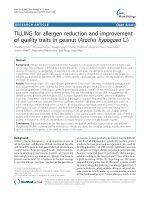
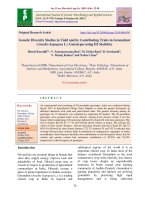
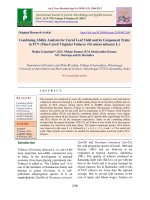
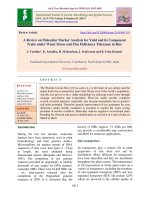
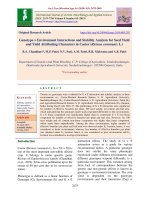
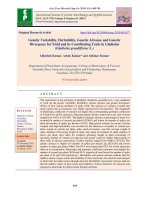
![Genetic parameters for grain yield and nutritional quality traits in foxtail millet [Setaria italica (L.) Beauv.]](https://media.store123doc.com/images/document/2020_01/13/medium_tvq1578927783.jpg)
![Genetic variability studies in F2 segregating populations for yield and its component traits in Okra [Abelmoschu sesculentus (L.)Moench]](https://media.store123doc.com/images/document/2020_01/13/medium_nxs1578931693.jpg)
